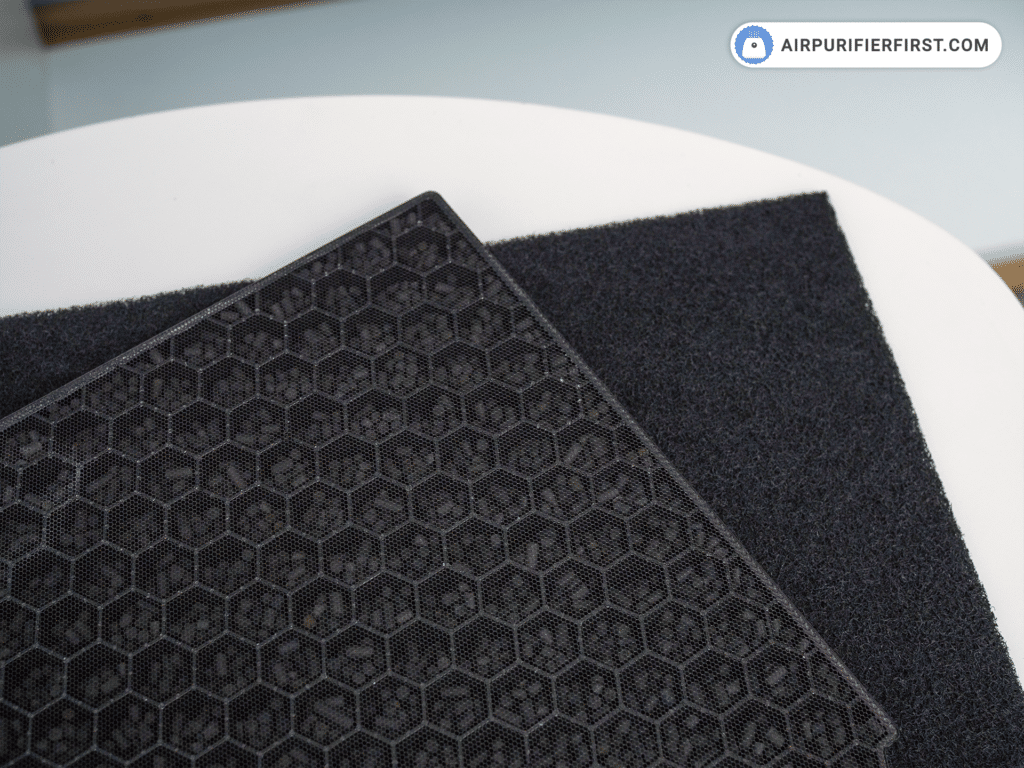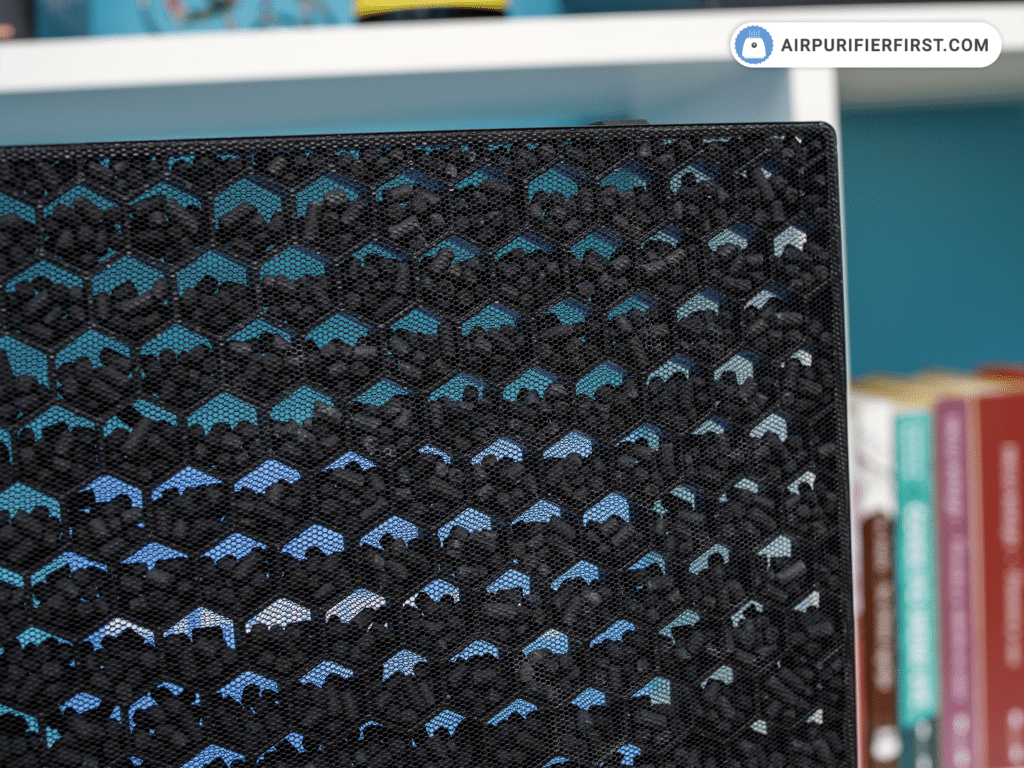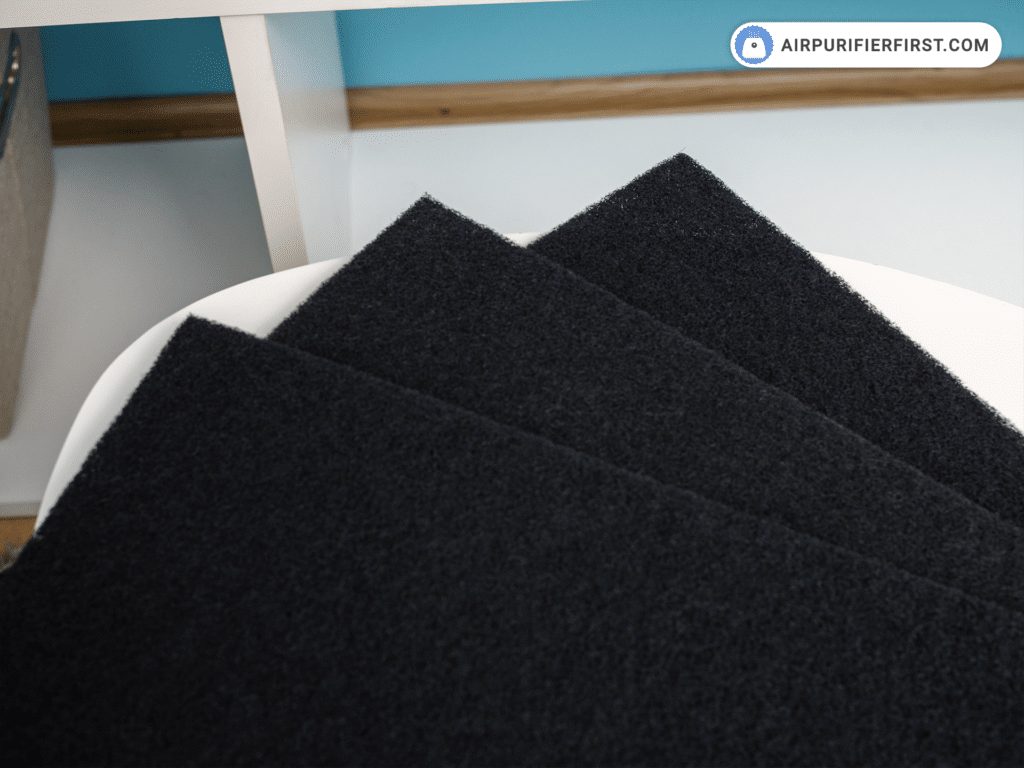An activated carbon filter is one of the main filtration layers in almost any household air purifier. This filter neutralizes bad odors, VOCs, formaldehyde, paint smells, and similar contaminants.

What’s characteristic of an activated carbon filter is that it works on the principle of adsorption, meaning this filter traps contaminants inside the pore structure of a carbon substrate. What’s more, these filters are used not only in air purifiers but also in water filtration and other industries.
If you are struggling to get rid of bad odors such as cooking smells, pet smells, smoke, mildew, or similar, an air purifier with an activated carbon filter is the way to go. An activated carbon filter will remove bad odors, VOCs, and other contaminants from your home, making the air smell much fresher and also reducing the health effect on your body from these containments.
In this guide, I will explain what an activated carbon filter in an air purifier is, its benefits, the types of carbon filters, and what you should consider when purchasing an air purifier with an activated carbon filter.
Key Findings on Activated Carbon Filters!
- An activated carbon filter is an important component in almost any household air purifier, which effectively neutralizes bad odors, VOCs, formaldehyde, paint smells, and similar contaminants.
- The activated carbon filter works on the principle of adsorption, trapping contaminants inside the pore structure of a carbon substrate.
- These filters aren’t only used in air purifiers but also in water filtration and various other industries.
- Activated carbon is essentially active charcoal created by heating at high temperatures, then mixed with certain chemicals and heated again, leading to a highly adsorbent filter.
- The more carbon an activated carbon filter has, the better the filtration quality and the longer the filter will last.
- Activated carbon filters can effectively remove various types of contaminant vapors from the air, including gases, odors, VOCs, cooking odors, mold smell, formaldehyde, paint smells, evaporations, second-hand smoke, household chemical odors, and even ozone.
- When purchasing an air purifier, you should always consider whether the device uses a pellet-based carbon filter or a fibrous filter coated with carbon. The pellet-based carbon filter is generally more efficient at neutralizing bad odors due to its larger amount of carbon.
- Activated carbon filters usually last up to 6 months, with some exceptions where they could last up to 1 year.
How Does an Activated Carbon Filter Work?
The filtering process of carbon filters is called adsorption. An activated carbon filter uses millions of pores and a large surface area to remove chemicals from the air.
Activated carbon is essentially active charcoal created by heating at high temperatures, after which it is mixed with certain chemicals and then heated again. Through this process, the carbon becomes activated and reacts when in contact with contaminants by adsorbing them.
In simple terms, during adsorption, compounds in the air react when they come into contact with the carbon and stick to it. Because of this process, I always recommend purchasing an air purifier that contains as much carbon as possible, as such a device will be able to adsorb a larger amount of chemicals from the air.
Adsorption Vs Absorption: The Difference!
Many people misinterpret the concepts of adsorption and absorption, which leaves them with an unclear understanding of how an activated carbon filter works. Essentially, an activated carbon filter removes particles from the air through a process called adsorption.
Adsorption is a process in which contaminants stick to the outside of the carbon in a way that when a contaminant comes into contact with the carbon, it attaches. Simple as that!

Absorption, on the other hand, is a slightly different process in which contaminants that come into contact with the carbon are absorbed into its structure.
So, adsorption essentially means that contaminants attach to the carbon filter, while absorption means that the carbon (or something else) soaks up the contaminants.
The adsorption process is beneficial because this filtration method allows the filter to trap organic chemicals, such as gases, from the air. However, this brings us to the most significant issue with these filters, which I’ve already mentioned. That is, when too many contaminants attach to the carbon filter through the adsorption process, it becomes clogged and almost ineffective. So, please remember this statement: the more carbon an activated carbon filter has, the better the filtration quality and the longer the filter will last.
What Types of Contaminants Activated Carbon Filters Remove?
An activated carbon filter removes various types of contaminant vapors from the air, including gases, odors, VOCs, cooking odors, mold smell, formaldehyde, and similar.
According to this research, activated carbon filters can also effectively remove ozone.
Moreover, these filters are efficient in removing paint smells, various evaporations, second-hand smoke, eliminating the odors of household chemicals, and similar.
But, Wait! Does it Remove Everything?
An activated carbon filter can’t remove all household contaminants; it has some limits, of course.
Unlike a standard HEPA filter (which is also found in most commercial air purifiers), which captures particles such as dust, smoke, pollen, allergens, and similar, an activated carbon filter absorbs contaminants from the air like gases, VOCs, and formaldehyde.
Did you know?
One gram of activated carbon has a surface area above 3,000m2 (32.000 sq. ft.).
How to choose the right activated carbon filter for your needs?
When purchasing an air purifier, you need to pay close attention to the filtration technology that the device uses. Regarding the carbon filter, you usually have two choices: to buy an air purifier with a pellet-based carbon filter or a fibrous filter coated with carbon.

The difference between these two types of carbon filters is significant, primarily concerning efficiency in neutralizing bad odors.
A pellet-based carbon filter generally contains more carbon than a fibrous filter coated with carbon, which is why this type of filter is much more efficient at neutralizing bad odors.
I have proven this fact in many tests that I conducted on dozens of air purifiers with either pellet-based or fibrous filters.
FAQs About Activated Carbon Filters
What is an activated carbon filter?
Made from activated carbon, an activated carbon filter will help neutralize bad odors, removing VOCs, formaldehyde, and many similar gases.
Why is activated carbon sometimes also called activated charcoal?
Some manufacturers practice calling this type of filter activated charcoal or activated carbon. The essence is that in both cases, it refers to the same type of filter; only a different name is used.
Are activated carbon filters washable?
No, they aren’t. However, some air purifier manufacturers suggest washing/refreshing their activated carbon filters, which is something I wouldn’t always recommend.
How often should you change the activated carbon filter?
These filters aren’t long-lasting because they absorb particles and can lose their capabilities rapidly if the environment becomes overpopulated with VOCs and similar contaminants. But, in my experience, activated carbon filters usually last up to 6 months, with some exceptions where they could last up to 1 year.
How does an activated carbon filter work?
Activated carbon filters use adsorption, a chemical process that traps contaminants within the pore structure of the carbon substrate. This process allows the filters to efficiently trap gases, chemical vapors, and odors from the air, making them an essential part of almost any air filtration system.
Are activated carbon filters safe?
Yes, activated carbon filters are safe to use. They are used for medical, environmental, cosmetic, residential, and agricultural applications.
Final Thoughts
Essentially, an activated carbon filter is one of the most crucial filtration types we encounter daily. You’ll most often notice they are used in water and air filtration, but they are also frequently used in industry.
Honestly, I would never buy an air purifier that doesn’t have an activated carbon filter, and I would always look for one with a pellet-based carbon filter containing as much carbon as possible.
A high-quality activated carbon filter will remove mainly all gases, unpleasant odors, and contaminants we encounter in an average household. It’s also important to highlight that such a filter will remove VOCs and formaldehyde, some of the most widespread contaminants in our homes.
If you have any questions about these filters, suggestions, or anything you would like to comment on, please leave a comment in the comment box below.
Leave a Reply